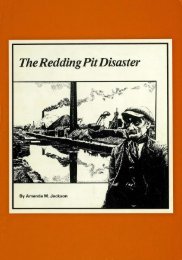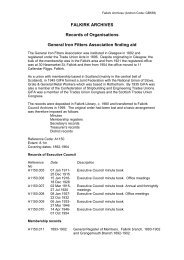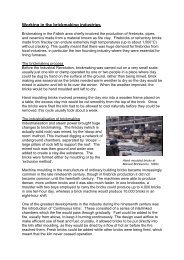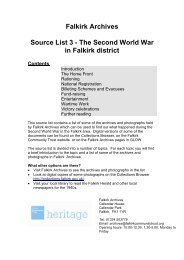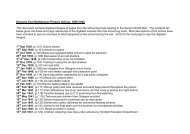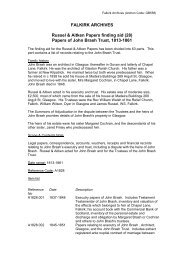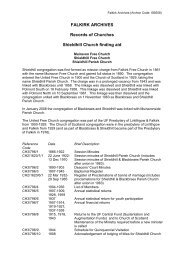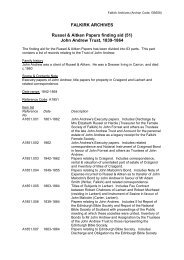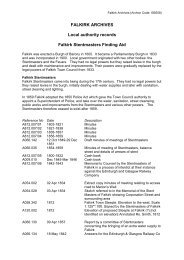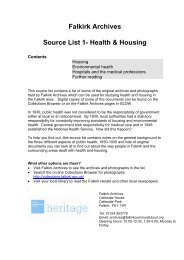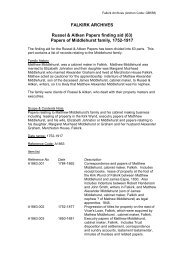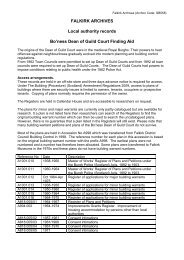Redding Pit Disaster Source List - Falkirk Community Trust
Redding Pit Disaster Source List - Falkirk Community Trust
Redding Pit Disaster Source List - Falkirk Community Trust
Create successful ePaper yourself
Turn your PDF publications into a flip-book with our unique Google optimized e-Paper software.
<strong>Falkirk</strong> Archives<br />
<strong>Source</strong> <strong>List</strong> 2 - <strong>Redding</strong> <strong>Pit</strong> <strong>Disaster</strong>,<br />
1923<br />
Contents<br />
<strong>Redding</strong> <strong>Pit</strong> <strong>Disaster</strong><br />
Health and Safety in Coal Mining in<br />
Scotland<br />
Hazards in Coal Mining<br />
Further Reading<br />
<strong>List</strong> of sources in <strong>Falkirk</strong> Council Archives<br />
This source list contains a list of some of the archives and photographs held<br />
by <strong>Falkirk</strong> Archives which can be used for studying the <strong>Redding</strong> <strong>Pit</strong> <strong>Disaster</strong><br />
and mining in the <strong>Falkirk</strong> area. Digital versions of some of the documents<br />
can be found on the Collections Browser or on the <strong>Falkirk</strong> Archives pages in<br />
GLOW.<br />
The <strong>Redding</strong> <strong>Pit</strong> <strong>Disaster</strong> tells us about changes in attitudes to the safety of<br />
mineworkers. To help you get started this source list includes a brief<br />
introduction to the history of industrial relations and health and safety in coal<br />
mining.<br />
What other options are there?<br />
Visit <strong>Falkirk</strong> Archives to see the archives and photographs in the list<br />
Search the on-line Collections Browser for photographs<br />
http://collections.falkirk.gov.uk/<br />
Visit your local library to read the <strong>Falkirk</strong> Herald and other local<br />
newspapers.<br />
Talk to your school librarian about borrowing books on mining disasters<br />
<strong>Falkirk</strong> Archives<br />
Callendar House<br />
Callendar Park<br />
<strong>Falkirk</strong>, FK1 1YR<br />
Tel: 01324 503779<br />
Email: archives@falkirkcommunitytrust.org<br />
Opening hours: 10.00-12.30, 1,30-5.00; Monday to<br />
Friday
<strong>Redding</strong> <strong>Pit</strong> <strong>Disaster</strong><br />
<strong>Pit</strong> 23 of <strong>Redding</strong> Colliery was the site of a flood in September 1923. Sixtysix<br />
men were trapped by the flood, and most of these men died. Some of the<br />
survivors were in the mine for up to nine days before they were rescued and<br />
some of these men never fully recovered from the effects.<br />
The flood itself occurred because a sump had been cut in a dyke to collect<br />
water, but the location of this sump was not properly recorded and coal was<br />
stripped from the area, weakening the sump and so flooding the mine. The<br />
disaster was compounded by poor working practices, which meant that noone<br />
knew exactly how many men were in the mine at the time of the flood.<br />
The rescue effort was hampered by the lack of reliable plans of the mines and<br />
by the difficult access above ground for the ambulances. Gas, rockfalls and<br />
more flooding were hazards throughout the rescue.<br />
In 1923 <strong>Redding</strong> Colliery was owned by James Nimmo & Co. The land was<br />
owned by the Duke of Hamilton who also owned the rights to the minerals in<br />
the whole area.<br />
Following the disaster, a public inquiry was held in Glasgow as well as the<br />
statutory fatal accident inquiry which was held at <strong>Falkirk</strong> Sheriff Court.<br />
The public inquiry recommended that correct records be kept of who was in a<br />
mine at any one time, that better telephone communications should exist<br />
below ground and that new legislation should be put in place regarding mining<br />
in areas approaching water.<br />
The flood was a disaster for the people of <strong>Redding</strong> and the Braes, where<br />
most of the men had come from. Quite apart from the grief of losing<br />
husbands, fathers, brothers and sons, the families affected also lost their<br />
breadwinners. Many of the survivors were never able to work in the mines<br />
again and it was some months before the mine itself re-opened.<br />
The <strong>Redding</strong> <strong>Disaster</strong> Relief Fund was opened by the Provost of <strong>Falkirk</strong> a few<br />
days after the disaster and subscriptions poured in from Scotland and from<br />
other countries, including Australia and the United States. The Fund was<br />
used to give allowances to the widows and children of the men who died and<br />
allowances to the men who survived because most of them were unable to<br />
work again. In the 1920s Britain did not have a national welfare system.<br />
Also, as there was no National Health Service, any medical needs had to be<br />
paid for, and so the Fund provided expenses for the survivors to go to<br />
convalescent homes.
Health and Safety in Coal Mining in Scotland<br />
Coal mines have always been dangerous places to work. In earlier centuries<br />
it was so dangerous that mine owners found it difficult to get people to work in<br />
the mines. And so, from 1606 until 1799, legislation gave the mine owners<br />
various powers over mineworkers which prevented miners from working<br />
elsewhere.<br />
It became almost impossible for a mineworker to leave the mine. Mine<br />
owners were able to force any beggars or homeless people to work in the<br />
mines. If the mine was sold, the mineworkers were transferred to the new<br />
owner. Mineworkers could also be moved to any other mine their master<br />
owned. Mine owners therefore had no incentive to provide reasonable<br />
working conditions.<br />
This system was abolished by two Acts, in 1775 and 1798, but it left a legacy<br />
of hostility between mineworkers and mine owners. One result was that<br />
miners were among the first to try to set up trade unions at a time when trade<br />
unions were illegal, and trade unionism has been a strong, unifying force in<br />
the mines ever since. Mineworkers, through their trade unions, have been an<br />
important voice in making mines safer.<br />
During the 19th century there were various attempts to improve conditions.<br />
The Coal Mines Act, 1842, stopped the employment of women and children<br />
underground and introduced Inspectors of mines. From then on, the<br />
government took increasing responsibility for regulating the mining industries.<br />
In 1850 the Act for the Inspection of Coal Mines in Great Britain gave<br />
inspectors the responsibility of collecting information about accidents and the<br />
right to prosecute anyone who infringed safety rules. Other acts in the next<br />
few years brought in several important safety regulations.<br />
It became compulsory to have at least two exits from every mine.<br />
Managers of mines had to pass an examination in competency.<br />
Mineworkers were given the right to appoint their own representatives to<br />
inspect mines.<br />
Following this legislation, the trade unions set up systems of safety<br />
inspections.<br />
Industrial relations were poor during the first few decades of the 20th century.<br />
There were many strikes over working conditions. With the outbreak of the<br />
First World War, there was a shortage of coal, partly because so many<br />
miners enlisted in the army. The Sankey Commission, set up by the<br />
government after the war recommended that coal mines should be<br />
nationalised, working hours underground be limited to six hours per day and<br />
wages be increased by 2 shillings a week. However, the mines remained in<br />
private hands and working conditions worsened. By the 1920s, strikes and<br />
lock-outs were frequent and there was also high unemployment.
Hazards in Coal Mining<br />
The main dangers in mines are from dangerous gases, coal dust, subsidence<br />
and flooding.<br />
Black damp is a non-poisonous, non-inflammable gas mixture of nitrogen,<br />
oxygen and carbon dioxide which uses up the oxygen in the air .<br />
Fire-damp is methane, a flammable gas.<br />
White-damp is carbon monoxide, which is colourless and odourless and<br />
which kills by combining with human haemoglobin and preventing the<br />
blood from carrying oxygen.<br />
Further reading<br />
Local newspapers contain the best contemporary accounts of the <strong>Redding</strong> <strong>Pit</strong><br />
<strong>Disaster</strong>. You will find copies of these on microfilm in the local libraries.<br />
Some are indexed.<br />
The <strong>Falkirk</strong> Herald<br />
Grangemouth Advertiser<br />
Bo’ness Journal<br />
The main source is the report of the public inquiry<br />
Report on the causes of and circumstances attending the Inrush of Water<br />
which occurred at the <strong>Redding</strong> Colliery, <strong>Falkirk</strong>, Stirlingshire on the 25th<br />
September 1923<br />
Sir Thomas H Mottram, C B E (London, HMSO, 1924. Cmd 2136)<br />
Other useful books about mining are:<br />
R Page Arnot A History of the Scottish Miners (1955)<br />
National Coal Board A Short History of the Coal Mining Industry 1958)<br />
Baron F Duckham A History of the Scottish Coal Industry (1970)<br />
You can find out what happened at the <strong>Redding</strong> <strong>Pit</strong> <strong>Disaster</strong> by reading the<br />
book “The <strong>Redding</strong> <strong>Pit</strong> <strong>Disaster</strong>” by Amanda M Jackson. A digital version of<br />
this book is available on the website .
How to use the <strong>List</strong> of <strong>Source</strong>s<br />
The list below is intended to help you choose which original items will be<br />
useful for your investigation. You should read it before you visit <strong>Falkirk</strong><br />
Archives<br />
A typical entry in a source list looks like this:<br />
Accession No Date Brief Description<br />
A101.001/01 1963 News cutting with interview of John Miller,<br />
survivor of the <strong>Redding</strong> <strong>Pit</strong> <strong>Disaster</strong>. Written at<br />
time of Lengede <strong>Disaster</strong><br />
The Accession No at the left hand side is used to identify the item. Give this<br />
number to the staff in <strong>Falkirk</strong> Archives when you want to see a particular<br />
archive or photograph.<br />
The Date is the date the item was written or photographed. It helps you put<br />
the item into the correct historical context.<br />
The Brief Description tells you about the contents of the item. You should<br />
read this carefully to decide if you want to see the original. Reading the<br />
descriptions helps you to narrow down your search for useful items.
<strong>Redding</strong> <strong>Pit</strong> <strong>Disaster</strong> <strong>Source</strong> <strong>List</strong><br />
Archives<br />
Souvenirs and articles about the <strong>Redding</strong> <strong>Pit</strong> <strong>Disaster</strong><br />
A101.001/01 1963 News cutting with interview of John Miller,<br />
survivor of the <strong>Redding</strong> <strong>Pit</strong> <strong>Disaster</strong>. Written at<br />
time of Lengede <strong>Disaster</strong><br />
A101.001/03 nd Handwritten personal reminiscences of life as a<br />
soldier in the First World War and as an<br />
onlooker at the <strong>Redding</strong> <strong>Pit</strong> <strong>Disaster</strong>.<br />
A101.001/02 1923 "Souvenir in affectionate remembrance of the<br />
men who lost their lives in the <strong>Pit</strong> <strong>Disaster</strong>,<br />
<strong>Redding</strong> Stirlingshire." Paper tissue souvenir of<br />
the <strong>Redding</strong> <strong>Pit</strong> <strong>Disaster</strong>. Contains list of men<br />
who died in disaster. Border of violets.<br />
A873.002 Typed copy of letter written by the late Thomas<br />
Thomson, 38 Comely Place, <strong>Falkirk</strong>, to his wife<br />
and children, while trapped in <strong>Redding</strong> <strong>Pit</strong><br />
A276.01 1923 Sep 25 Poem "In Memory of No 23 <strong>Redding</strong> Colliery<br />
<strong>Disaster</strong>, Lower <strong>Redding</strong>, Stirlingshire"<br />
A347.001/01 1923 Poem "The <strong>Redding</strong> Coal <strong>Pit</strong> <strong>Disaster</strong>" by<br />
John Fleming<br />
A406.01 1958 Oct 03 Evening Telegraph. Contains article on the<br />
<strong>Redding</strong> <strong>Pit</strong> <strong>Disaster</strong>, on 35th anniversary.<br />
A1034.005 1923 Dec 29 Forward newspaper. Includes article and<br />
comment on organisation of the <strong>Redding</strong><br />
<strong>Disaster</strong> Relief Fund.
Records of the <strong>Redding</strong> <strong>Disaster</strong> Relief Fund<br />
A1034.001 1923 Draft deed of trust establishing the <strong>Redding</strong><br />
<strong>Disaster</strong> Relief Fund by the Provost of <strong>Falkirk</strong><br />
and the proprietor of the <strong>Falkirk</strong> Herald. Also<br />
includes example of other trust deeds<br />
A1034.002 1923 Scheme for the administration of the funds<br />
raised for relief of the sufferers by the disaster<br />
which occurred at <strong>Redding</strong> Colliery (No 23 <strong>Pit</strong>)<br />
near <strong>Falkirk</strong> on 25th September 1923<br />
A812.009/01 1923-1966 Minutes<br />
A812.009/02 1923-1966 Letter book<br />
A812.009/03 1943 Index to Letter Book<br />
A066.034 1923-1924 Special Letters. Contains correspondence<br />
relating to administration and disbursement of<br />
funds<br />
A066.033 1923 <strong>List</strong> of subscribers with amounts subscribed<br />
A1034.003 1923-1931 <strong>List</strong>s of beneficiaries and dependants<br />
A066.002 1923-1924 Account book. Contains notes of payments to<br />
dependants, allowances to survivors, train<br />
fares to Saltcoats Convalescent Home and<br />
sundry payments<br />
A1034.004 1923-1946 Financial statements, synopses of allowances<br />
to beneficiaries, investments and information<br />
on surviving beneficiaries<br />
A812.009/04 1924-1946 Abstract of Accounts<br />
A1034.006 1924-1925 Abstract of accounts<br />
A1034.007 1925 Abstract of accounts<br />
A1034.008 1926 Abstract of accounts<br />
A1034.009 1927 Abstract of accounts<br />
A1034.010 1928 Abstract of accounts<br />
A1034.011 1929 Abstract of accounts<br />
A1034.012 1930 Abstract of accounts<br />
A1034.013 1931 Abstract of accounts<br />
A1034.014 1932 Abstract of accounts<br />
A1034.015 1933 Abstract of accounts<br />
A1034.016 1934 Abstract of accounts<br />
A1034.017 1935 Abstract of accounts<br />
A1034.018 1936 Abstract of accounts<br />
A1034.019 1937 Abstract of accounts<br />
A1034.020 1938 Abstract of accounts<br />
A1034.021 1939 Abstract of accounts<br />
A1034.022 1940 Abstract of accounts<br />
A1034.023 1941 Abstract of accounts<br />
A1034.024 1942 Abstract of accounts<br />
A1034.025 1943 Abstract of accounts<br />
A1034.026 1944 Abstract of accounts<br />
A1034.027 1945 Abstract of accounts<br />
A1034.028 1946 Abstract of accounts<br />
A1034.029 1947 Abstract of accounts<br />
A1034.030 1948 Abstract of accounts<br />
A1034.031 1949 Abstract of accounts<br />
A1034.032 1950 Abstract of accounts<br />
A1034.033 1951 Abstract of accounts
A1034.034 1952 Abstract of accounts<br />
A1034.035 1953 Abstract of accounts<br />
A1034.036 1954 Abstract of accounts<br />
A1034.037 1955 Abstract of accounts<br />
A1034.038 1956 Abstract of accounts<br />
A1034.039 1957 Abstract of accounts<br />
A1034.040 1958 Abstract of accounts<br />
A1034.041 1959 Abstract of accounts<br />
A1034.042 1960 Abstract of accounts<br />
A1034.043 1961 Abstract of accounts<br />
A1034.044 1962 Abstract of accounts<br />
A1034.045 1963 Abstract of accounts<br />
A1034.046 1964 Abstract of accounts<br />
A1034.047 1965 Abstract of accounts<br />
A1034.048 1966 Abstract of accounts<br />
A1034.049 1966 Report on investments and annuities<br />
A1034.050 1953-1966 Financial statements and correspondence<br />
A1034.051 1957-1966 General ledger
Photographs<br />
P02803 Circa 1930s Union Canal at <strong>Redding</strong> <strong>Pit</strong> Union Canal<br />
passing <strong>Redding</strong> <strong>Pit</strong>; scene of pit disaster in<br />
1923<br />
P12447 Circa 1890 Female Mine Workers at <strong>Redding</strong> <strong>Pit</strong><br />
P15008 1924 Surviving miners from <strong>Redding</strong> <strong>Pit</strong> <strong>Disaster</strong><br />
Formal group of the five men who were trapped<br />
for 10 days<br />
Miller, John (L); Ure, Robert (3 from L);<br />
Donaldson, John (R); Thomson, Andrew (2<br />
from L); Jack, James (4 from L)<br />
P16326 Circa 1917 Group of miners at <strong>Redding</strong> <strong>Pit</strong><br />
G Sneddon(far R) ,T Sneddon (2nd<br />
R),Morrison (3rd R).<br />
P16950 1923 Sep 25 View of <strong>Redding</strong> <strong>Pit</strong><br />
P16951 1923 Sep 25 <strong>Redding</strong> <strong>Pit</strong> <strong>Disaster</strong> : crowds waiting<br />
P16952 1923 Sep 25 <strong>Redding</strong> <strong>Pit</strong> <strong>Disaster</strong> : crowds waiting View<br />
from above : crowds waiting at entrance to pit<br />
P16953 1923 Sep 25 <strong>Redding</strong> <strong>Pit</strong> <strong>Disaster</strong> : crowds waiting Women<br />
and children waiting at pit entrance<br />
P16954 1923 Sep 25 <strong>Redding</strong> <strong>Pit</strong> <strong>Disaster</strong> : crowds at pump<br />
Pumping out water into the Union canal.<br />
Crowd of men around pipe and colliery in<br />
background<br />
P16955 1923 Sep 25 <strong>Redding</strong> <strong>Pit</strong> <strong>Disaster</strong> : subsidence Area of<br />
subsidence roped off<br />
P17019 1988 <strong>Redding</strong> <strong>Pit</strong> <strong>Disaster</strong> Memorial<br />
P17020 1988 <strong>Redding</strong> <strong>Pit</strong> <strong>Disaster</strong> Memorial<br />
P17021 1988 <strong>Redding</strong> <strong>Pit</strong> <strong>Disaster</strong> Memorial Detail of plaque<br />
with names
Other Records relating to Coal Mining<br />
A208.028 1879-1887 Invoices, <strong>Redding</strong> Colliery Co<br />
A003.025/01 1888 Apr 07 News report on coal discovery at Coneypark<br />
Estate during survey of proposed line of Kilsyth<br />
and Bonnybridge Railway<br />
A003.025/02 (Circa 1888) Report on transport access to Coneypark<br />
Colliery.<br />
A003.026 (Circa 1888) Report on transport access to Banknock Colliery<br />
on the Kilsyth and Bonnybridge Railway<br />
A003.033 1888 Apr 11 Statement of coke received at Denny station for<br />
twelve months ending Dec 1887<br />
A003.035/02 1887 Report on coal traffic at Larbert Station<br />
A003.047 1888 Jun 09 Letter, D McRae to J Clapperton, concerning<br />
quarrying of whinstone at Northfield Farm,<br />
Denny, and proposed railway to Stirling<br />
A003.049/09 1958 News cuttings relating to coal mining disputes,<br />
productivity and union matters<br />
A005.009 Feb 1944 Report on the minerals and mineral working<br />
under and in the vicinity of the proposed site for<br />
the new Roman Catholic Church at Bo'ness<br />
A005.023/01 1847 Notice: Rules and regulations for the Grange<br />
Colliery and works connected with it<br />
A005.023/10 Mar 1939 Notice placing all employees of Bridgeness<br />
Colliery on one day's notice<br />
A005.023/11 Post 1925 Notice under Workmen's Compensation Act,<br />
1925<br />
A005.023/13 Early 20th Shot firing notice under Workmen's<br />
Century Compensation Act,1925<br />
A005.028/03 Photocopy of map of Grange showing coal waste<br />
and pits(SRO Ref:RHP 687)<br />
A005.034 1951 Jun 25 Souvenir programme for official inauguration of<br />
the new linking and development at Kinneil<br />
Colliery. Contains historical note on Kinneil,<br />
photographs of Kinneil House, remains of Wall<br />
and Roebuck's former workshop and<br />
Furnaceyard <strong>Pit</strong><br />
A037.021 May 1829 Report by J Lauder on the north coal field of<br />
Callendar. (part of report missing)<br />
A037.038 1808 Advertisement of sale or subset of unexpired<br />
lease of Callendar colliery held from William<br />
Forbes for 19 years from 1804<br />
A058.001 Nov 1924 Plan showing unknown coal mine, Bo'ness<br />
A058.012 1880 Plan of the town of Bo'ness showing schoolyard<br />
<strong>Pit</strong> workings and associated dykes and mine<br />
shafts.<br />
A058.160 1929 Nov 11 Plan of wall tracings at Faulis and Kinneil Coal<br />
Co, at Bo'ness, for Shieldhill proposed road<br />
across Kinneil Bings.<br />
A059.003 (Early 20th Photocopy of map "Carbrook Mine Lower Fireclay<br />
Century) Seam"<br />
A066.044 General section showing the seams of coal and<br />
their approximate depths in the <strong>Falkirk</strong> area
A066.135 1851 Report by Alexander Black, Surveyor to the<br />
Committee of Stentmasters for Improving the<br />
Supply of Water. Relates to supply of water from<br />
<strong>Falkirk</strong> Muir and effect of coal mining<br />
A066.136 1851 Report to the Stentmasters by a Committee<br />
appinted at a meeting held on 12th October<br />
1849. Accompanies report of Alexander Black,<br />
Surveyor (see A066.134). Relates to water from<br />
<strong>Falkirk</strong> Muir and effect of coal mining<br />
A066.137 1850 Jun 18 Report by Alexander Black, Surveyor to the<br />
Committee appointed by the Stentmasters of<br />
<strong>Falkirk</strong> for the purpose of superintending the<br />
operations in the coal water under the Common<br />
Muirs<br />
A133.02 Johnston Coal Workings; taken from plan by<br />
United Collieries Ltd.<br />
A204.001 (1957) Photocopy of poem "In these dark hazards" by<br />
Geo. Sneddon. Relates to coal mining<br />
A259.03 (1967) Sketch plan showing extract of mine workings<br />
under the western fields of Kendieshall Farm to<br />
1967<br />
A310.01 1911 Feb 28 Lecture with lime-light lantern views delivered to<br />
Carronshore Continuation Classes (Mining<br />
Section) on Carronshore School, on "Faults met<br />
with in Coal Mining in Scotland"<br />
A529.001 Photocopy of pp 82-85 of "The British Coalmining<br />
Industry" Relates to employment of women and<br />
children in mines and includes illustration of<br />
notice for <strong>Redding</strong> Colliery, 1845<br />
A599.01 1956 Jun 21 Photocopy of programme for visit to Kinneil<br />
Colliery Alloa area by the Institute of Mining<br />
Engineers, summer meeting, 1956. Includes<br />
history of sinking and development of two shafts<br />
A650.001 Dec 1847 Map of Bo'ness showing Kinneil Mineral Field,<br />
West Division




